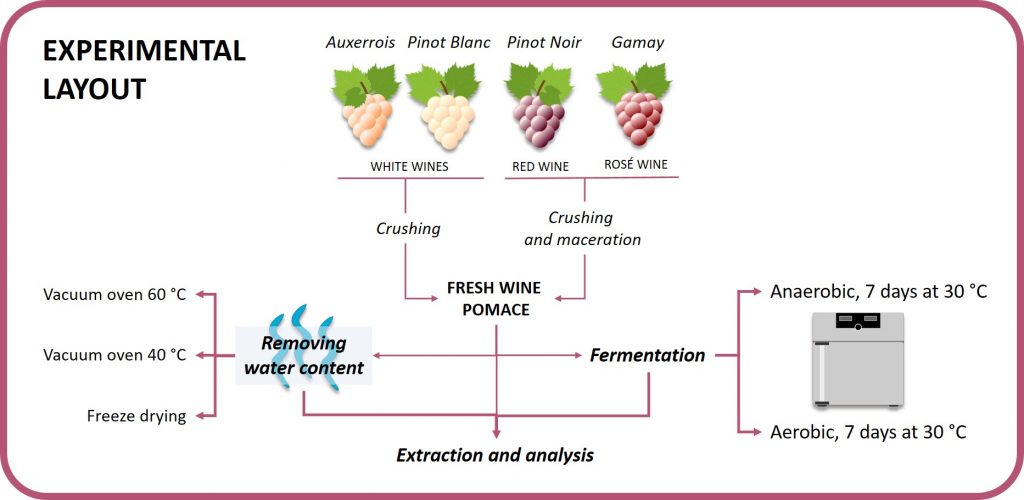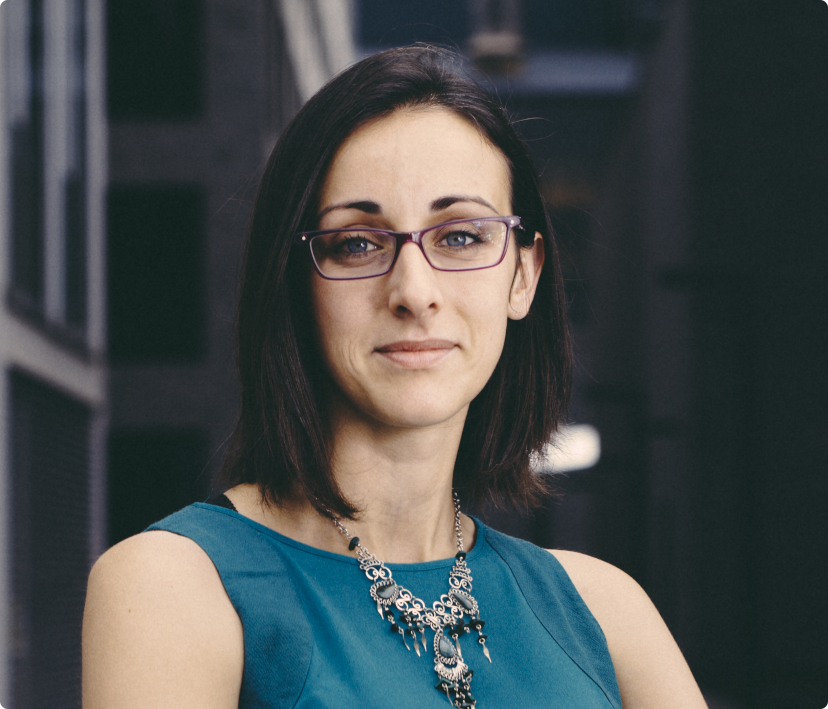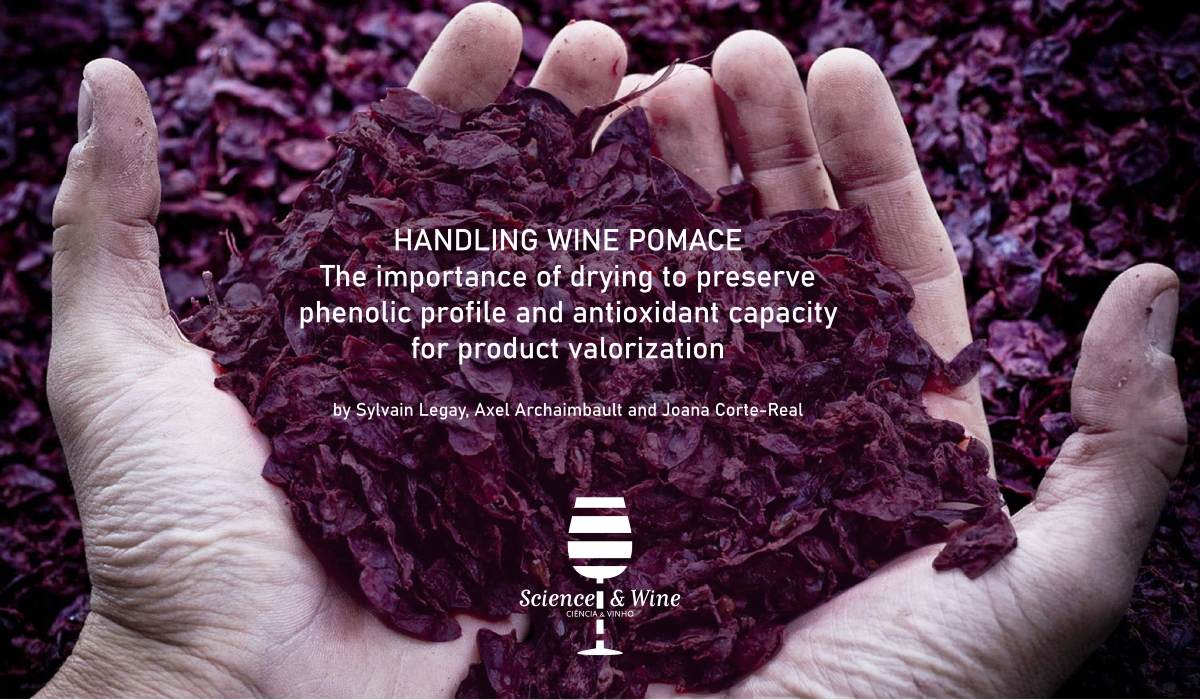by Sylvain Legay, Axel Archaimbault and Joana Corte-Real
For detailed information please refer to the original article:
Journal of Food Science, doi:10.1111/1750-3841.15652, 2021
The wine industry and valorization of wine pomace
Like other industries, winemaking produces waste. Wine pomace (WP), composed of stems, seeds and skins of grapes, is the main solid organic by-product and it represents approximately 25% of total grape weight used in the winemaking process 1. WP is commonly valorized for the production of distilled spirits (e.g. Grappa), tartaric acid, and animal feed 2,3. Still, the most common practice is to use it for composting and agriculture spreading, which comes with environmental drawbacks. WP is rich in phenolic compounds, which are slightly acidic molecules but in high volumes and concentrations they lower the pH of the soil and increase oxygen demand in ecosystems 1,2. Phenols are also known for their antioxidant capacity and are associated with the prevention of certain chronic diseases 4,5. As such, there is an economic opportunity for valorization in the fields of health and nutraceuticals as the consumers’ demand for bio-sourced products is on the rise.
In the Grand Duchy of Luxembourg, the wine growing area is by far the main permanent crop with 1.293 ha occupied in 2019, mainly in the Moselle region, and with an average wine production of 99 514 hL over the last 10 years, primarily white wine 6. Given their potential for valorization, there is an interest to investigate WP from local wineries to produce extracts that could be used in, for example, the formulation of food supplements. And so the ACTIVITIS project was born, out of a collaboration between the Luxembourg Institute of Science and Technology (https://www.list.lu/) and PM International (https://www.pm-international.com), with the aim of developing a dietary supplement from Luxembourg’s wine industry by-products (https://www.list.lu/en/news/from-winemaking-by-product-to-dietary-supplement/).
Taking a product from lab to industrial scale is a multi-step process. Our first step in this project was to define strategies to stabilize WP for long-term storage. We investigated four varieties of wine grape (Vitis vinifera) pomace supplied by a local winemaker in the Moselle valley area: Pinot Blanc and Auxerrois from white wines; Pinot Noir from red wine; and Gamay from rosé wine.

Drying to conserve wine pomace quality
In Luxembourg most winery biomass is produced between end of August and October, during grape harvest season. This implies collecting and handling in a short timeframe tons of WP. If not quickly conditioned, they might spoil due to the high moisture content and microbiological activity.
To simulate microbiological spoilage under aerobic and anaerobic conditions, we left a sample of fresh WP in an incubator at 30 °C for 7 days. At the end, we compared phenolic profiles and antioxidant capacity between fresh and fermented samples. Microbiological development was visible at the end of the 7-day period, and fermented samples had a significantly lower antioxidant capacity compared to fresh WP. Fermentations led to an overall loss of total phenolics and individual phenols. Some exceptions were the simpler phenolic acids (gallic, syringic, hydroxybenzoic, vanillic, caftaric, and chlorogenic acids), whose concentration increased due to fermentation. This phenomenon is likely connected to the bioconversion of conjugated polyphenols into their more bioactive free forms.
To prevent spoilage, WP needs to be stabilized, which can be achieved by drying (or dehydration) for example. We chose to compare freeze drying and vacuum oven drying (at 40°C and 60°C). These two methods are commonly used industrially and allow removing moisture content at relatively low temperatures (< 100 °C). Also, we wanted to mitigate losses of sensitive compounds due to high temperatures. The results from a drying kinetics showed that the dry matter of WP by either freeze drying or vacuum drying at 60°C reached a plateau around 48 hours, and that for both methods we were able to conserve an antioxidant capacity of the extracts similar to that of fresh pomace. As for vacuum drying at 40 °C, this method was less efficient in removing moisture content, since even after 96 hours we had still not reached a plateau for the dry matter. Although the milder temperature might be better to avoid thermal degradation of certain compounds, the longer drying period provides a favorable environment for microbiological growth, which eventually might lead to some degree of spoilage.
Not all wine pomaces are alike.
Red wine grapes are usually richer in polyphenols than white wine grapes. However, when it comes to WP the opposite might occur. The first step of winemaking involves crushing the grapes to release the juice. Skins, seeds and stems will remain mostly intact and this is also where we find the majority of phenolic compounds. The next steps depend on the type of vinification. For white wine, the pomace is immediately separated and discarded. For rosé and red wine, there is a maceration step and the pomace is left in contact with the juice for a variable period of time, depending on the type of wine and the producer’s “recipe”. During maceration polyphenols are leached from the pomace into the must, which gives color to the wine.
The analysis of pomaces from different grapes and vinification methods showed that those derived from white and rosé wines have more phenolic compounds and higher antioxidant capacity than grape pomace derived from red wine. This observation seems to make sense when we take the maceration into account. The shorter the maceration time, the less phenols leak into the must. And for white wines, where no maceration occurs, the majority of the phenols will remain on the pomace.
In countries where white wine is predominant, such as Luxembourg, this finding can shift the focus from the more popular red wine pomaces towards the valorization of white wine pomace instead. However, a strategy for the long-term storage of tons of GP is necessary and it is an essential step in the valorization chain of this promising biomass at the industrial scale.

Sylvain Legay 
Axel Archaimbault 
Joana Corte-Real
Sylvain Legay got his PhD in agronomical science and bio-engineering from the Université catholique de Louvain, Belgium on ‘unravelling genetic components of apple russeting’. Sylvain Legay acquired his first scientific expertise employed in Limagrain Verneuil Holding, an international breeding company working on the identification of QTLs linked to pathogen resistance in wheat and the improvement of the cytoplasmic male sterility systems in rape seeds. In 2007, he joined the CRP-Gabriel Lippmann where he strengthened his skills in transcriptomics applied to the detection of genes linked to abiotic stress tolerance and health promoting secondary metabolites biosynthesis in plants. In 2015, he joined the Luxembourg Institute of Science and Technology (LIST) and further developed his expertise in plant science and bioprocesses using integrated approaches combining molecular biology, functional genomics, transcriptomics, analytical chemistry, bioprocesses and plant cell suspension culture.
Axel Archaimbault is a Food R&D Engineer at PM-International AG Luxembourg, since April 2018. He works on the development of food supplements and ingredients sourcing, and is also involved in collaborative research activities together with the Luxembourg Institute of Science and Technology. He has an Engineering Master degree in Agriculture and Food industry (2017), from UniLasalle France. In 2017 he also graduated from Gembloux AgroBio Tech – University of Liège (Belgium) with a Master degree in Agriculture and Bio-Industries with a specialisation in Biorefinery, Biomass valorization and Wood Chemistry. His Master thesis topic was “Valorisation of grape pomace for the production of bioactive compounds with high added value in a context of circular economy”.
Joana Corte-Real has been working with plant bioactives since 2012, when she joined the team of Dr. Torsten Bohn at the Luxembourg Institute of Science and Technology (LIST), as a PhD student, to study the effect of divalent cations on the bioavailability of dietary carotenoids in vivo and in vitro. In 2018 she received her doctorate degree from the Technical University of Kaiserslautern and re-joined LIST as a Junior R&T Associate at the Plant Biotechnologies Group. She worked on the valorization of plant by-products, focusing on the extraction of bioactive compounds and its antioxidant and anti-inflammatory properties, and bioavailability. Since April 2021, she has decided to focus on science communication working as a freelance medical writer. Linkdin: https://lu.linkedin.com/in/joana-cortereal
References
- Beres C, Costa GNS, Cabezudo I, et al. Towards integral utilization of grape pomace from winemaking process: A review. Waste Manag. 2017;68:581-594. doi:10.1016/j.wasman.2017.07.017
- Teixeira A, Baenas N, Dominguez-Perles R, et al. Natural bioactive compounds from winery by-products as health promoters: A review. Int J Mol Sci. 2014;15(9):15638-15678. doi:10.3390/ijms150915638
- Arvanitoyannis IS, Ladas D, Mavromatis A. Potential uses and applications of treated wine waste: A review. Int J Food Sci Technol. 2006;41(5):475-487. doi:10.1111/j.1365-2621.2005.01111.x
- Georgiev V, Ananga A, Tsolova V. Dietary Supplements/Nutraceuticals Made from Grapes and Wines. In: Moreno-Arribas MV, Sualdea BB, eds. Wine Safety, Consumer Preference, and Human Health. Springer International Publishing Switzerland; 2016:1-323. doi:10.1007/978-3-319-24514-0
- Wu CF, Yang JY, Wang F, Wang XX. Resveratrol: Botanical origin, pharmacological activity and applications. Chin J Nat Med. 2013;11(1):1-15. doi:10.1016/S1875-5364(13)60001-1
- Superficie des vignes, rendement en vin, valeur de la récolte et qualité du moût 1938 – 2019. Le Portail des Statistiques Grand-Duché de Luxembourg. https://statistiques.public.lu/stat/TableViewer/tableViewHTML.aspx?sCS_ChosenLang=fr&ReportId=13382. Published 2020.

